|
1.
CENTRAL/ WEST AFRICA
Mid-month price levels hold in West Africa
Continuing price trends from mid-January, West African
exporters have held all log prices unchanged through the
end of January. Demand has not changed and buyers for
China are maintaining their policy of purchasing a more
limited number of species. Indian demand remains firm for
belli, but at slightly lower prices than negotiated at the end
of 2007. There are signs of a revived interest in okan and it
is possible prices may recover from the recent lower levels
resulting from falling demand in the past year. Sipo and
sapele have held firmly to recent price gains for both logs
and lumber. Exporters are less nervous about more
competitive prices for Far East species. The early February
celebrations for the Chinese New Year will cause the
normal slow down in logging and sawmilling.
Consequently, there is unlikely to be any surge in
production until mid-February.
Although all traders are watching the global market
carefully, the full impact of the market seems not to have a
sharp bearing on the industry. The fall of U.S. housing
prices and house demand, together with a reported surplus
of unsold new-build housing in Spain, are affecting timber
markets. However, it does appear that the major impact of
the U.S. market is likely to be on South American and
Asian suppliers rather than on the lesser volume of trade
with West Africa. Freight rates are high and have not
changed after the moderate hikes in December 2007,
although this has not yet inhibited trade volumes. One
exporter recently noted some difficulty in obtaining
shipping space for Europe, although this seemed not to be
a significant problem.
As with logs, prices for sawn timber are unchanged from
mid-month levels. Although markets are still said to be
quiet, demand has remained moderate, possibly helped by
the mild winter conditions so far in Europe, where rain is
more of a problem for the construction sector than the
normal snow and ice. However, continental European and
UK buyers are being very cautious over concerns about
the full effects of the U.S. credit crunch. Sapele and sipo
are in demand and moabi also continues to be popular.
Okoume, douka/makore and movingui remained in good
demand and are unchanged at recent higher prices. While
there are no forecasts for the medium term, experts say
prices should remain stable at least until the end of February.
DRC receives USD64 million for forest reforms
TTJ Online reports that the World Bank will provide funds
to strengthen forestry reforms in the Democratic Republic
of Congo after the Bank¡¯s Inspection Panel found
¡®significant policy compliance failures¡¯ in the country. A
total of USD64 million will be provided by the Bank to
address these deficiencies, including measures to improve
consultations on forest strategies with indigenous people.
The funds will enable the country to develop new forest
management strategies and schemes.

2. GHANA
Government revises forest revenue sharing ratio
The government has revised the sharing ratio of revenue
from the country¡¯s forests. Traditional authorities will now
receive 60% instead of 40% of revenue accruing from
outside forest reserves. Resource owners will receive 50%
of the revenue from on-reserve forests and the Forestry
Commission will receive the remaining 50% of the
revenue, instead of the previous ratio of 40/60
respectively.
The Deputy Ministry of Lands, Forestry and Mines, Mr.
Adjei Yeboah, who made the announcement at the first
National Forest Forum (NFF) in Accra, explained that the
changed ratios were designed to stimulate community
enthusiasm in forest management and alleviate poverty
among the local people. The Forum was attended by
delegates from 10 regions comprising traditional leaders
and officials from the Forestry Commission and the
Ministry of Lands, Forestry and Mines. The Forum, the
first of its kind, was designed to serve as a neutral
platform for stakeholders to discuss the numerous forestry
issues at both the national and local levels. It is anticipated
the Forum will in the future serve as a basis for advocacy
to effect changes in policies and laws inimical to
sustainable forest management and collaborative forest
management practices. Mr. Yeboah said the NFF was
complementary to the government¡¯s efforts to promote
collaborative resource management in the country. He said
the Ministry was pursuing various policies and
programmes aimed at securing and restoring the resource
base and ensuring equitable distribution of benefits from
the resource to relevant stakeholders.
Mr. Alex Asare, Manager of the Collaborative Resource
Management Unit of the Forestry Commission, reminded
delegates that the foremost task of the new Forum would
be to pressure political parties to make sustainable forest
management a priority. The Chief Executive Officer of the
Forestry Commission, Prof. E.N. Ashie-Kotey,
emphasized that the Forum would enable all stakeholders
in the forestry sector to have access to knowledge, skills
and information, thus promoting transparency,
accountability, effectiveness and coherence in the
management of Ghana¡¯s forests.
Ghana wins emerging economy award
Thomson Financial¡¯s International Financing Review
(IFR) has recognized Ghana as the world¡¯s most renowned
emerging economy in 2007, said the Daily Graphic.
Ghana emerged as the winner following a year of intense
scrutiny and monitoring of emerging global economic
activities by Thomson IFR. The award represents the key
industry benchmark of global capital markets and national
economic excellence. The award was presented in London
at the 13th Annual Awards Gala Dinner attended by over
1,500 senior investment bankers, economists and
representatives of governments form around the globe.
Ghana¡¯s Minister of Finance and Economic Planning, Mr.
Kwadwo Baah-Wiredu, expressed delight that his
country¡¯s economic upturn had impressed the world. He
extended invitations to investors to participate in Ghana¡¯s
economy. The Editor of Thomson Financial¡¯s IFR, Mr.
Matthew Davies, said lessons on Ghana¡¯s economic
progress were very relevant, particularly for countries in
Africa and other developing economies.
Inflation inches up
The rate of inflation for December 2007 stood at 12.7%,
compared to 11.4% in November 2007, the Ghana
Statistical Service reported. The December increase was
due to higher spending patterns of consumers during the
Christmas holidays. The Bank of Ghana also maintained
the prime interest rate at 13.50%.
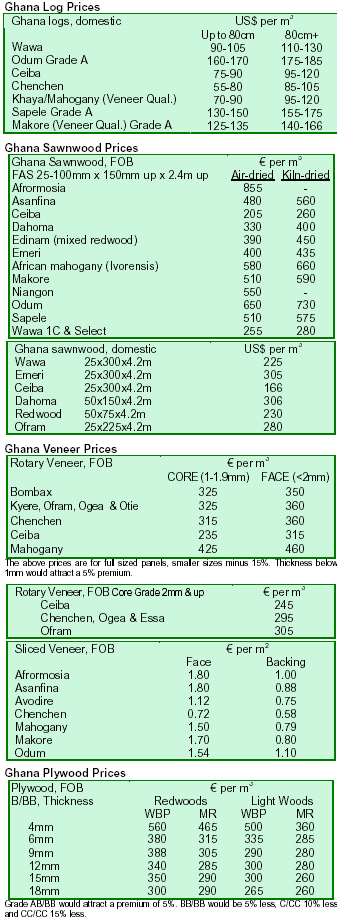

3.
MALAYSIA
Malaysian forest plantation fund breaches 1 billion ringgit
level
According to Bernama online, the Malaysian government
will add RM865 million to its Forest Plantation
Development Fund that will raise the total value of the
fund to over RM1 billion. The purpose of the Fund is to
develop 375,000 hectares of forest plantations over a 15-
year period. The Malaysian Timber Industry Development
Board (MTIB) has already dedicated RM267.65 million to
the fund and has formed the Forest Plantation
Development Sdn Bhd to help disburse the funds. The
Minister of Plantation Industries and Commodities, Datu
Peter Chin Fah Kui, noted that the Ministry of Finance has
already agreed to lower the interest rate on loans from 3.5
to 3.0% for borrowers under the Fund. He noted the
companies listed on the local stock exchange were also
eligible to apply for the funds if the local equity level of
the stock was above 51%. The Minister also said degraded
land or land with secondary forests would also be used for
activities under the Fund.
As reported in The Edge Daily, Minister Chin also
responded to the proposed EU ban on fuel imports derived
from crops on land including forests, wetlands and
grasslands. In response to this announcement by the EU,
the Minister said that Malaysia only grew oil palm on
designated agricultural sites, not within its forest reserves.
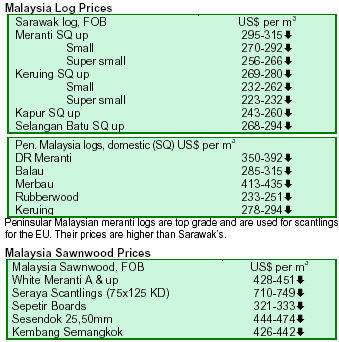
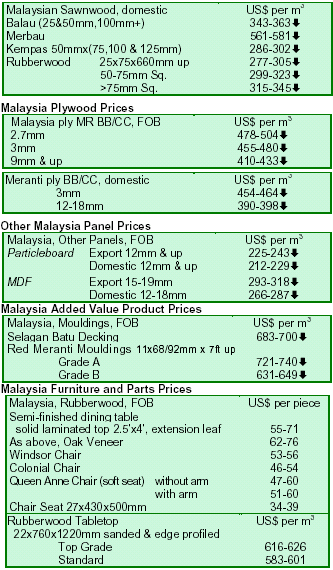
4.
INDONESIA
Indonesian Central Bank to defend sagging rupiah
In light of recent fears over the value of the rupiah, the
Indonesian central bank, Bank Indonesia, said it would
defend the rupiah to minimize any ¡®impact¡from the
current shift in global sentiments¡¯, reported Antara News.
On 22 January 2008, the rupiah fell to 1-1/2 year lows
against the U.S. dollar, due to heightened volatility in U.S.
markets. Consequently, some speculated the central bank
might intervene, although it said it would not be disturbed
by recent global market events. However, the weakness of
the Indonesian currency has benefited the Indonesian
timber industry for now, as more buyers move away from
the Malaysian market and enter the Indonesian market.
Nevertheless, prices of Indonesian and Malaysian timber
products continue to decline in tandem with the slide in
global financial markets.
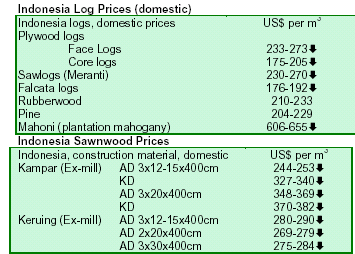
5.
MYANMAR
Solid demand for teak pushes prices higher
Demand for teak was reported to be good, with prices for
lower grade logs increasing at the end of the month.
Tamalan, also known as Myanmar tulipwood, had been
sold this month and was equally expensive as padauk.
Below is a sample of sawn teak prices from the private
sector. While these are price samples for export
destinations, the actual sales price quotations may vary on
a case by case basis. Only prices for teak boards, teak
planks, teak decks, and teak mini decks are given.
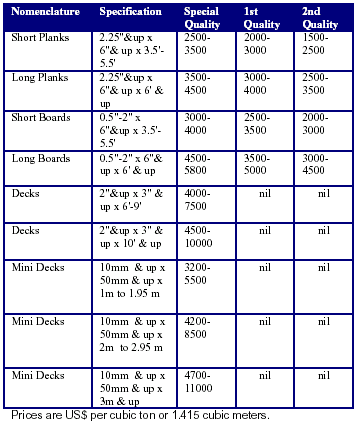
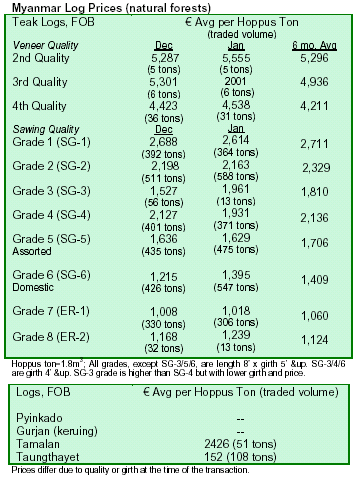
6. PAPUA
NEW GUINEA
PNG logs show stability in prices and exports
During the first three weeks of January 2008, PNG forest
products showed active trading for logs. However, there
appeared to be no apparent improvement in PNG log
prices. China continued to be the dominant buyer of logs,
while Taiwan and Australia imported more processed
timber products. The summary of forest products exports
are as follows:
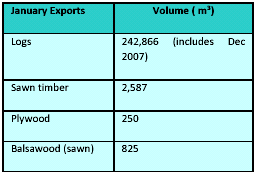
PNG to establish State Marketing Agency for forest
products
By June 2008, the PNG government intends to establish
the State Marketing Agency (SMA) to assist industry with
the promotion of PNG¡¯s timber trade. The Minister of
Forests, Honorable Belden Namah MP, made public his
intention to increase forest products trade by promoting
products as well as clearing any misunderstanding about
the legality and source of tropical timber. The SMA is not
meant to compete with the timber industry, but to assist
with the development of effective marketing and
promotional networks. Under the National Forest Policy,
the government expresses the need to promote PNG¡¯s
forest products, including non-timber forest products. The
policy also intends to minimize transfer pricing through
active involvement in market promotion. One element that
needs further resolution under the Policy is the State
Purchase Option (SPO) agreed between the government
and concession holders. The SPO clauses are in every
permit and project agreement. Under the SPO, the
government seeks to obtain 25% of export volumes from
exporters. The State, through the PNG Forest Authority,
would sell the SPO logs to any buyer who would offer
better than average FOB prices. This will assist the
government in keeping the log price at par or close to the
market price. The current method of monitoring price
levels is, according to experts, inconsistent and sporadic,
which will not serve the purpose of an SPO. The SMA
will, therefore, take over the SPO functions as well as
spearhead promotional programmes.
National Agricultural Development Plan piques
concern over forests
The PNG government has committed USD35 million
annually to be spent over the next 10 years under the
National Agricultural Development Plan, although experts
are concerned actions under the Plan may result in
permanent forest loss. The Forestry Act has been amended
to facilitate the Plan and some say it may target forested
areas to be cleared for agriculture development. The
changes to the Forestry Act will also result in less control
of forest clearance operations by the PNG Forest
Authority once an area is designated for agriculture
development.
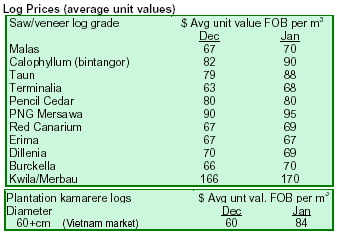
7.
BRAZIL
Brazilian CPI doubles as Real remains firm
The Brazilian Consumer Price Index (IPCA) increased
0.74% in December 2007. This was the largest increase in
2007 and nearly twice as much as the November 2007 rate
(0.38%).
In December 2007, the average exchange rate was
BRL1.78=1USD, resulting in a 20.8% appreciation in the
currency from December 2006 levels. The Committee on
Monetary Policy (Copom) decided for the second time to
maintain the prime interest rate (Selic) at 11.25% per year.
Cattle ranching drives recent Amazon deforestation
Agecia de Noticias da Amazoia indicated that
deforestation in the Amazon may be increasing due to
rising financial incentives given by state banks such as the
Bank of Amazon (BASA). According to one major
newspaper, small to large-size cattle ranchers in the state
of Par?have received BRL80 million from the National
Program of Family-Owned Agriculture (PRONAF) and
the Constitutional Fund of the Northern Region (FNO) to
expand their activities in the region, which in turn has led
to increased deforestation. It is estimated that cattle
ranchers in the Northern region received BRL1.89 billion
from the FNO from 2003 to 2007. News reports also
suggest that an internal rule of BASA exempts loan
applicants from providing proof of legal forest reserves.
BASA offers subsidized interest rates for cattle ranching
activities ranging from 0.5% to 10.5%, a rate considered
one of the lowest in the country.
Real-time inspections to control logging in public
forests
Radiobras reported that the government may conduct realtime
forest inspections on publicly-owned land. The first
public bidding process for public forests began in the
second week of January, with eight participants competing
for three areas of the Jamari National Forest, located in the
Amazonian state of Rodonia. The Ministry of the
Environment noted the forest areas would be awarded to a
company that presents the best proposal from an
environmental, social and economic perspective. The
winner of the bid also receives concession rights for a 40-
year period, calculated on the natural forest regeneration
cycle of about 30 years. The inspection of the logging
process in the Jamari Forest would be done by the
Brazilian Institute of Environment and Natural Resources
(IBAMA), the Brazilian Forest Service (SFB) and by the
state and local government agencies. This will facilitate
the National Environment System (SISNAMA) in
monitoring logging activities.
Exports of wood products dip marginally in December
In December 2007, Brazil¡¯s exports of wood products
(except pulp and paper) fell 0.8% compared to the same
period of 2006, dropping from USD341.1 million in 2006
to USD338.2 million in 2007. The following charts
indicate wood products exports for December 2007:
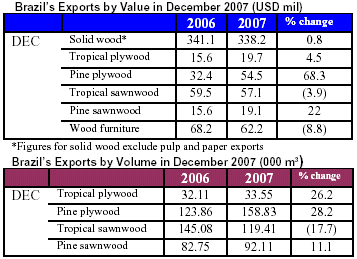
Falling dollar dampens exports from West-Central
Brazil
The falling U.S. dollar may continue to influence the
forest sector of the state of Mato Grosso, the major
tropical timber producing state in the Amazon, said Síž®
N힮ticias. While the Wood Industry Union (SINDUSMAD)
said that exports were likely to continue falling, the
domestic market may grow in 2008. Exporters of plywood
and other wood products have faced difficulties due to
exchange rate losses that have drastically affected profit
margins. On the other hand, the domestic wood market has
been expanding due to developments in the civil
construction market, which may balance the difficulties
faced with export levels. The timber industry sector is
likely to focus on the domestic market in 2008 to recover
any financial loss, although SINDUSMAD did not dismiss
the alternative option that companies would continue
investing in exports. The weaker value of the U.S. dollar
makes exporting difficult, since the selling price does not
cover production costs. The favorable trends seen in the
domestic market, which focuses on expanding
agribusiness and high-value commodities, will likely spur
civil construction. As a result, there is an expectation of
more investment and higher wood demand in the Amazon
region.
Asian SMEs seek business opportunities in Brazil's
forest sector
Globo noted that small and medium-sized companies in
Asia and the Middle East are seeking business
opportunities in the Brazilian forest products sector. Many
partnerships have already been established through
international agreements, business missions and product
fairs. The Brazilian Agency for the Promotion of Exports
and Investments (APEX-Brazil) will convene a meeting
this year with 61 sector companies that maintain export
projects in Brazil. Already, China, Cuba, and Arab
countries have been engaged in early discussions.
One goal of APEX is to design a commercial strategy for
Asian countries by 2008. Special attention has been given
to China and the Agency aims to jointly collaborate with a
Chinese partner in setting up the strategy. In addition, the
Minister of Foreign Relations of Cuba visited the
Industrial Federation of Sao Paulo (FIESP) in search of
new commercial partnerships. The Arab-Brazilian
Chamber of Commerce, which facilitates trade with 22
countries of the League of Arab States is positive about
new opportunities in Brazil. In 2007, trade between Arab
States and Brazil reached BRL14 billion and projections
for 2008 suggest a possible growth of 10%. The
opportunities available to these countries and regions
would be especially beneficial to micro and small-scale
furniture enterprises in addition to companies targeting
civil construction.
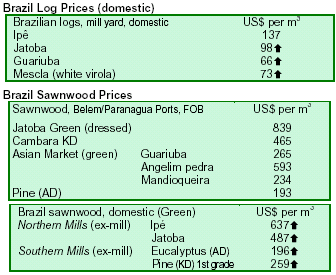
8. PERU
Peruvian bank calls for strong forest investment
framework
According to the fourth quarter 2007 report of Banco
Continental of Peru, the promotion of investment in forest
activities holds a huge potential for the country. However,
a sound framework must be created to ensure investments
are environmentally and socially sustainable. The report
noted such a framework is needed to determine the
involvement of sub-national entities linked to the
management of geographic areas and to incorporate legal
mechanisms for properties belonging to communities
surrounding concessions or in sale zones. The report
suggested the need for clarity of ownership so properties
could be integrated and communities could be the direct
beneficiaries of investments instead of individual owners.
The report says it is essential to have such elements, to
avoid the same problems faced by the mining sector such
as social conflicts, environmental problems and the
negative impact on the general population¡¯s quality of life.
Peruvian Bank shows interest to invest in Amazon
region
Wilfredo Lafosse Quintana, President of the Bank of
Commerce, revealed the bank was willing to invest in the
Amazon region, and will work specifically to promote
certification in forest concessions. He said that
¡®concession owners cannot use nor exploit lumber because
they do not know exactly how many hectares they
own¡and don¡¯t¡have certification [of their lands].¡¯ The
Bank of Commerce was holding talks with foreign entities
interested in the project. Lafosse noted that the bank¡¯s aim
is to certify a million hectares of the Peruvian forest. He
also said that a pilot scheme would first be developed in
the zone of Mazan (province of Maynas, region of Loreto),
where around a million hectares could be certified.
SNV calls for development of Peru biofuels sector
The Netherlands Development Organization (SNV in
Dutch) reported that biofuels in Peru, and in particular the
Amazon region, should be promoted under policies
designed to guarantee sustainable development. This can
be done, they noted, by establishing mechanisms to allow
farmers engaged in productive biofuels chains to obtain
income. The SNV report also said that the impact on
natural forested areas must be avoided when developing
areas for biofuels and priority must be given to the use of
degraded and abandoned forested areas. The SNV stressed
that it was necessary to foment research on introduced
crops and develop a profitable technology package.
According to SNV, the research could be the baseline of
the biofuel business in the Peruvian Amazon. The report
also clarifies many points of confusion related to biofuels
management such as supporting the private sector and
regional governments in the development, implementation
and diffusion of inclusive and sustainable business
patterns of biofuels in the Peruvian Amazon.
Peruvian shipping company acquires new vessel
Naviera Yacu Puma S.A., the only shipping line with a
Peruvian flag, will shortly acquire a new vessel in order to
complement its cargo service from Iquitos Port, located in
the Loreto region, to North American ports. The company
pointed out that the new vessel will facilitate a monthly to
ensure the constant flow of wood products exports. Due to
the current shortage of capacity, most of the forest
companies located in Loreto need to ship their products
through Callao Port on the Peruvian coast and bear the
resultant increase in costs. Loreto accounts for about 20%
of total Peruvian exports and foreign exports of wood
products from the Loreto region have grown sustainably in
the last twelve years.
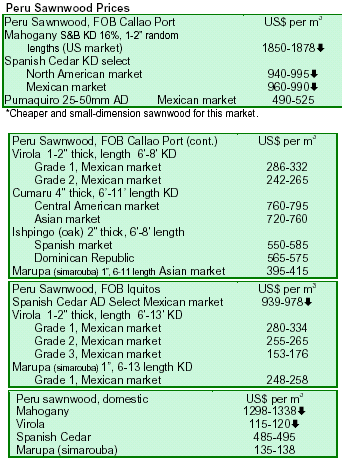
9. BOLIVIA
Bolivian wood exports surge 10% in 2007
In 2007, Bolivian wood exports reached a total of USD115
million, a 10% jump from the total value of exports in
2006. Despite slower overall export growth from 2006,
high value-added (HVA) products exports accounted for
more of the total amount of exports. In terms of value,
HVA products represented 62.5% of total wood exports in
2007 compared to 55.5% in 2006. In terms of volume,
HVA products made up 39.3% of the total in 2006 and
42.5% in 2007. As sawn lumber exports have stagnated in
terms of volume and prices, the growth in HVA products
supported the overall sector¡¯s growth. The US share of
total Bolivian exports by volume represented 35.6%,
compared with 46% in 2006. Other markets, such as the
UK, gained in importance and surpassed China as the
second main buyer of Bolivian exports. Other markets like
Argentina, the Netherlands, France and Italy also
increased their intake of Bolivian wood products exports
in 2007.
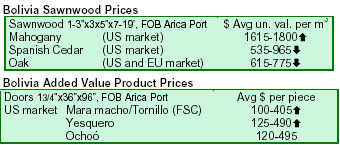
10.
Guyana
FPMC highlights achievements of Guyana forestry
sector
Minister of Agriculture Robert Persaud, officials of the
Forest Products Marketing Council of Guyana (FPMC),
the Guyana Forestry Commission, including
Commissioner James Singh, the Guyana Manufacturers
Association (GMA) and the Forest Products Association
met to discuss the FPMC¡¯s performance and its future
directions. The FPMC was established in December 2005
by the Government, after an ITTO diagnostic review of
the forestry sector in 2002 recommended the establishment
of the Council. The Council was established to coordinate
marketing activities, provide advice on the types of wood
in demand and address and explore lesser-used species
(LUS).
Minister Persaud highlighted the consultative approach
taken with regard to the Council¡¯s operations over the past
two years and said the country would continue to place
emphasis on valued-added production. FPMC¡¯s Director,
Luvindra Sukraj, reported on the success of the Council¡¯s
operations, saying that forest products exports earnings
jumped from USD43 million in 2005 to USD61.5 million
in 2007, when there was a reduction in log exports.
It was noted that the Council addressed almost all the
areas outlined in its business plan, including exposure for
value-added production and understanding the use and
promotion of LUS. Another area of emphasis was on
training in such areas as timber grading and sawdoctoring.
To address market requirements, the Council
also developed a Legal Verification System (LVS) and
operational plans are in place for its implementation.
As a result of the consultations on the FPMC, a working
group has been established to brief Minister Persaud on
forthcoming consultations in the next three weeks. The
consultations will continue to ensure that the views and
recommendations of all stakeholders are included.
Currently, Guyana¡¯s forestry sector contributes about 6%
to the country¡¯s GDP, employs some 25,000 workers and
plays a key role in the country¡¯s development, particularly
in the rural and hinterland communities where forestry
activities generate income for many households and
contribute to the national economy.
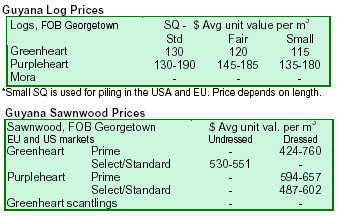
|